Dilutions and Modifiers of Coat Color in Cats
Cats exhibit a wide variety of coat colors, and as with all domestic animals, their colors are controlled by a variety of dilutions and modifiers. These dilutions and modifiers can occur alone or together and depending on the genes involved can produce a variety of distinct pigmentations. These include the Color point dilutions and albino all of which are located on the C locus, Dilution on the D locus, Chocolate and Cinnamon on the B locus, Orange on the O locus, and Silver on the I (originally inhibitor) locus.
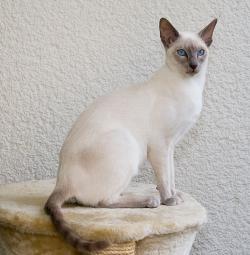
Lovely example of the Siamese Dilution (cscs) Open Source
Color Point and Albino
Color Point dilutions and Albino are the result of mutations at the "C" locus that codes for the enzyme Tyrosinase. There are currently four known alleles of the C locus in cats C, cs, cb, and c, with c being the most recessive and C being dominant. If the dominant allele C is present no dilution will express. The color point mutations are cs and cb. These two mutations restrict the expression of the tyrosinase enzyme (and therefore color) to the points where body temperature is lower ie the outer extremities. They will provide some level of dilution with cscs being the most diluted and cbcb being the least. The cscs cat is called Siamese, with the name being taken from the breed that first made the coloration popular. A cat that is cbcb is called Burmese or Sepia and will have much darker coloration. If both dilution alleles are present (cscb), the resultant color is between the two dilutions. These in-between cats are called Mink. Kittens with a color point dilutions are born a uniform color (because of the uniform temperature of the womb) with the points darkening as the kitten ages. The points will be the color or nearly the color the cat would have been without the color point dilution and can be of any color that otherwise occurs in cats. This can include, but is not limited to black, blue, chocolate, and Orange. Cats that are cscs will generally have blue eyes while cats that are cscb will generally have aqua eyes. Cats that are cbcb will generally have eyes that are golden or green. Albino is caused by the most recessive "C" allele. Cats that are cc will be albino while cats that are csc or cbc will express the respective color point mutation. Since true albino is the most recessive of the four alleles, it will only express when the cat or kitten is homozygous for the c allele. The cc cat is a true albino in that it lacks pigment or melanin. The lack of pigment results in an animal that is pure white with pink skin and very pale blue eyes that often have a pinkish hue. More Examples of Color Point and Albino
A self colored and a tabby kitten both displaying dilution. Notice the uniform "blue" coloration of the self colored kitten and the "blue" color of the darker stripes on the tabby. Open Source
Dilution
Dilution is responsible for the "blue" or "gray" coloration. Dilution affects both red and black pigment and also causes a dilution of skin coloration to a lesser extent. It is a recessive so a cat must be dd for dilution to express. Dilution dilutes black to a blue or gray and dilutes red to a cream color. Since Dilution affects both red and black pigment it is the cause of the Blue and Cream color which results when a Tortoiseshell cat is diluted by being dd. Dilution is caused by a mutation in the MLPH gene. It works by causing uneven distribution of pigment in the hair shaft. A mutation in the same gene causes a similar coat color in dogs. More Photos of DilutionFor more information about Dilution and the MLPH gene see Color Across Species part 2: MLPH
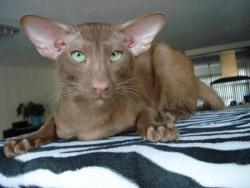
Koosje van Tutte´s Cinna-Mon Amour an Oriental cat and a wonderful example of Cinnamon blbl. Notice the light eyes and pink skin. Photo courtesy of Fiordiliso Siamese and Orientals
Chocolate and Cinnamon
Chocolate and Cinnamon are both caused by a mutation in Tyrosinase-related protein 1 (TYRP1). There are currently three known alleles of the B locus, B (wild-type), b, and bl. They are listed in the order of dominance. Cats that are bb and bbl will be Chocolate while cats that are blbl will be Cinnamon. Chocolate and Cinnamon only affect black pigment (eumelanin) but black skin is also diluted. Because only black pigment is diluted, the coat of Orange cats will not be affected and only non-red areas in calico or tortoiseshell cats will be affected. Cats that are self-colored Chocolate will appear a dark rich brown, while cats that are cinnamon will be a lighter brown the skin in both colorations will be diluted. The skin coloration in Cinnamon cats can actually be quite pink. For more information on TYRP1 mutations Color Across Species Part 3: TYRP1. For more photo examples Chocolate and Cinnamon Cats Photo Gallery
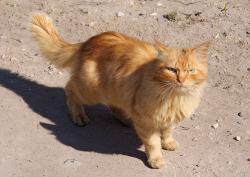
Orange Cat Open Source

Enigmatic Sexis Onfire - Oriental Chocolate Tortie photo courtesy of Fiordiliso Siamese and Orientals
Orange (Ginger)
Orange (often called Ginger) is one of the most interesting modifiers involved in cat coat color genetics. It is a sex linked trait, this means that males carriers express differently than females carriers. Orange is an co- dominant, but because it is located on the x chromosome, and males only have one x chromosome, only one copy is required for full expression in male cats (all males are xy). Females, on the other hand, have two x chromosomes (all females are xx) ; therefore two Orange alleles are required for full expression in female cats. We are all familiar with the Orange tabby but was this cat male or female? Did you check or just assume the cat was male? Because the male cat only requires one Orange allele for full expression (all ginger males will be Oo), Orange males are much more common than Orange females. However, Orange females do occur. If a female is homozygous for the Orange allele (OO), she will be Orange as well. In females, when only one O allele is present, both the Orange (O) and the wild-type allele (o) express. The resulting mosaic appearance is called Tortoiseshell or Calico. Tortoiseshell and calico only rarely appear in male cats. When it does occur, it is the result of an abnormal genetic combination, resulting in a male cat that is xxy (with one x allele carrying O) instead of the normal xy. Such males are very rare and almost always sterile. Orange acts by changing black pigment to red and is epistatic (overwrites) to self (non-agouti) in cats. This means that even if a cat is aa at agouti, if it is also carries an O allele, the areas of Orange in the coat will express as if an agouti allele was present. So, Orange cats will always express Agouti, even if its genetic code says it is aa and should be self-colored. If a female is aa Oo the dark areas of the coat will express solid while the reddened areas will express agouti. More examples of Colors Caused by Orange
A smoke colored cat. This coloration is the result of silver on a black cat. Notice the light appearance where the coat is parted. Open Source
Silver (Inhibitor)
Silver is a dominate allele that results in a change in pigmentation along the length of the hair. The tips of the hair will contain near normal pigmentation while the base of the hairs will be much lighter in appearance, most often a very silvery color from which the mutation takes its name. In self-colored (aa) cats this results in what is known as the "Smoke" phenotype. Silver has additional effects on the production of red pigment (pheomelanin) verses black pigment (eumelanin). In mackerel and classic tabby cats this results in what is known as a silver tabby where most if not all of the red is removed from the coat. The result is a cat with black stripes on an a silver or near white background. In Orange cats silver modifies the red pigment removing much of the "warm" tone. This color is often referred to as "Cameo".
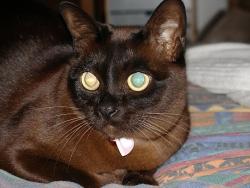
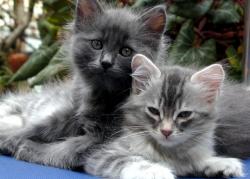

Black Smoke tabby?
wanted to know how that came about...